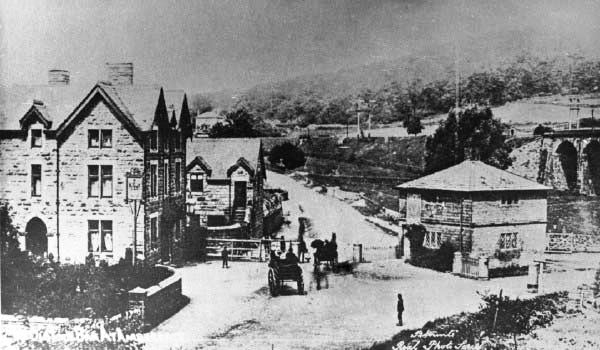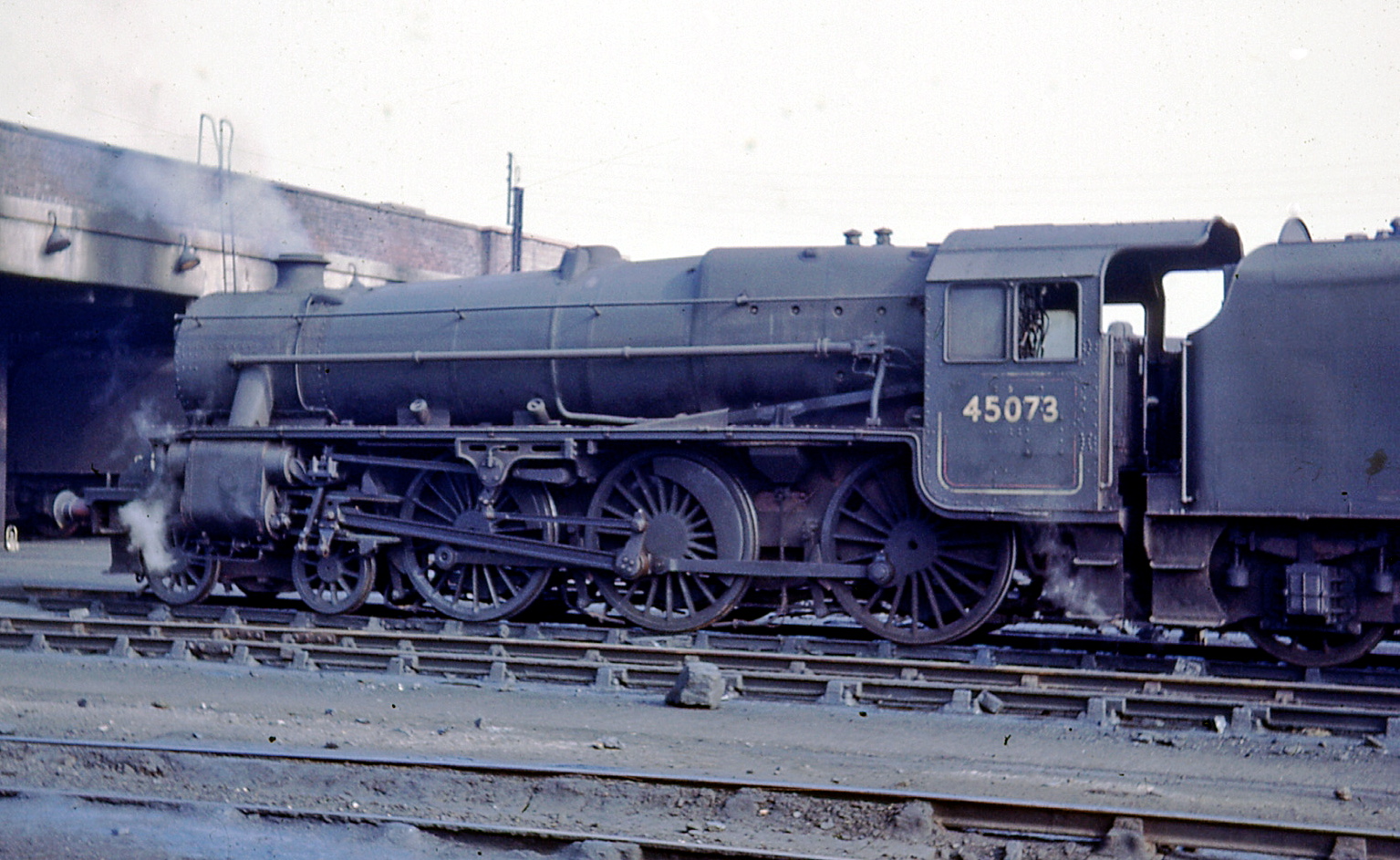|
LMS Garratt
The London, Midland and Scottish Railway (LMS) Garratt was a class of Garratt 2-6-0+0-6-2 steam locomotive designed for heavy freight. A total of 33 were built from 1927, making them the most numerous class of Garratt in Britain. Overview After Grouping, the LMS initially continued the Midland Railway's "small engine policy" of hauling trains using two or three locomotives of moderate power coupled together. This led to most of the Toton (Nottinghamshire)- Brent (London) coal trains being double-headed by 0-6-0 locomotives. It was realised that double heading was uneconomical so a Garratt locomotive, designed by Fowler, was ordered from Beyer, Peacock and Company to haul 1450 long tons at 25 mph. However, the LMS Derby design office insisted on, amongst other changes, the fitting of their standard axleboxes to the design. These axleboxes were barely adequate for the LMS Fowler Class 4F locomotives, on which they frequently overheated, and were a major weakness on the LMS Garratt ... [...More Info...] [...Related Items...] OR: [Wikipedia] [Google] [Baidu] |
0-6-0
Under the Whyte notation for the classification of steam locomotives, represents the wheel arrangement of no leading wheels, six powered and coupled driving wheels on three axles and no trailing wheels. This was the most common wheel arrangement used on both tender and tank locomotives in versions with both inside and outside cylinders. In the United Kingdom, the Whyte notation of wheel arrangement was also often used for the classification of electric and diesel-electric locomotives with side-rod coupled driving wheels. Under the UIC classification, popular in Europe, this wheel arrangement is written as C if the wheels are coupled with rods or gears, or Co if they are independently driven, the latter usually being electric and diesel-electric locomotives. Overview History The 0-6-0 configuration was the most widely used wheel arrangement for both tender and tank steam locomotives. The type was also widely used for diesel switchers (shunters). Because they lack lea ... [...More Info...] [...Related Items...] OR: [Wikipedia] [Google] [Baidu] |
Ambergate To Pye Bridge Line
Ambergate is a village in Derbyshire, England, situated where the River Amber joins the River Derwent, and where the A610 road from Ripley and Nottingham joins the A6 that runs along the Derwent valley between Derby to the south and Matlock to the north. Sawmills and Ridgeway are neighbouring hamlets, and Alderwasley, Heage, Nether Heage and Crich are other significant neighbouring settlements. The village forms part of the Heage and Ambergate ward of Ripley Town Council with a population of 5,013 at the 2011 Census. Ambergate is within the Derwent Valley Mills UNESCO World Heritage site, and has historical connections with George Stephenson; Ambergate is notable for its railway heritage and telephone exchange. Ambergate has an active community life, particularly centred on the school, pubs, churches, sports clubs; and annual village carnival which is relatively large and consistent locally, with popular associated events in carnival week and throughout the year. The car ... [...More Info...] [...Related Items...] OR: [Wikipedia] [Google] [Baidu] |
Manchester
Manchester () is a city in Greater Manchester, England. It had a population of 552,000 in 2021. It is bordered by the Cheshire Plain to the south, the Pennines to the north and east, and the neighbouring city of Salford to the west. The two cities and the surrounding towns form one of the United Kingdom's most populous conurbations, the Greater Manchester Built-up Area, which has a population of 2.87 million. The history of Manchester began with the civilian settlement associated with the Roman fort ('' castra'') of ''Mamucium'' or ''Mancunium'', established in about AD 79 on a sandstone bluff near the confluence of the rivers Medlock and Irwell. Historically part of Lancashire, areas of Cheshire south of the River Mersey were incorporated into Manchester in the 20th century, including Wythenshawe in 1931. Throughout the Middle Ages Manchester remained a manorial township, but began to expand "at an astonishing rate" around the turn of the 19th century. Manchest ... [...More Info...] [...Related Items...] OR: [Wikipedia] [Google] [Baidu] |
Hasland
Hasland is a suburb in the Borough of Chesterfield in the town of Chesterfield, Derbyshire, England. Hasland is located south of Spital, east of Birdholme and north of Grassmoor. Hasland is a ward of the Borough of Chesterfield. The ward population at the 2011 Census was 6,969. The A617 (Hasland By-Pass) links Hasland, along with Chesterfield, to the M1. The expansion of Hasland has created a dense array of shops and services, including: a theatre, three schools, three churches, two medical centres and a couple of industrial buildings. Eastwood Park In 1913, Alderman Eastwood (Mayor of Chesterfield, 1905–1908) donated the park to the public in memory of his late father. The Deputy Mayor, Ald. C.P. Markham, showed enormous gratitude in accepting the gift: "Hasland is now set up for all time. It has got a very wide street and Ald. Eastwood has finished it off by giving one of the most handsome parks there will be in this part of the world". The first condition on donating t ... [...More Info...] [...Related Items...] OR: [Wikipedia] [Google] [Baidu] |
Wellingborough
Wellingborough ( ) is a large market and commuter town in the unitary authority area of North Northamptonshire in the ceremonial county of Northamptonshire, England, 65 miles from London and from Northampton on the north side of the River Nene. Originally named "Wendelingburgh" (the stronghold of Wændel's people), the Anglo-Saxon settlement is mentioned in the Domesday Book of 1086 as "Wendelburie". The town was granted a royal market charter in 1201 by King John. At the 2011 census, the town's built-up area had a population of 50,577. The Wellingborough built-up area also includes suburbs Wilby, Great Doddington, Little Irchester and Redhill Grange. History The town was established in the Anglo-Saxon period and was called "Wendelingburgh". It is surrounded by five wells: Redwell, Hemmingwell, Witche's Well, Lady's Well and Whytewell, which appear on its coat of arms. Henrietta Maria came with her physician Théodore de Mayerne to take the waters on 14 July 1627. The ... [...More Info...] [...Related Items...] OR: [Wikipedia] [Google] [Baidu] |
Elstree Railway Station Garrat Geograph-2224566
Elstree is a large village in the Hertsmere borough of Hertfordshire, England. It is about northwest of central London on the former A5 road, that follows the course of Watling Street. In 2011, its population was 5,110. It forms part of the civil parish of Elstree and Borehamwood, originally known simply as Elstree. The village often lends its shorter name to businesses and amenities in the adjacent town of Borehamwood, and the names of Elstree and Borehamwood are used interchangeably. Elstree is perhaps best known for multiple Elstree Film Studio complexes, where many films were made, including BBC Elstree Centre, where the TV soap opera '' EastEnders'' is shot. This production centre is actually in Borehamwood. The local newspaper is the ''Borehamwood and Elstree Times''. Together with Borehamwood, the village is twinned with Offenburg in Germany, Fontenay-aux-Roses in France, and Huainan in China. Transport Elstree and Borehamwood railway station Elstree & Boreha ... [...More Info...] [...Related Items...] OR: [Wikipedia] [Google] [Baidu] |
LMS Stanier Class 5 4-6-0
The London, Midland and Scottish Railway (LMS) Stanier Class 5 4-6-0, commonly known as the Black Five, is a class of steam locomotives. It was introduced by William Stanier and built between 1934 and 1951, of which 842 were built and were numbered 4658-5499 (BR then renumbered 44658-45499). Several members of the class survived to the last day of steam on British Railways in 1968, and eighteen are preserved. Origins The Black Five was a mixed-traffic locomotive, a "do-anything go-anywhere" type, designed by Stanier, who had previously been with the GWR. In his early LMS days, he designed his Stanier Mogul in which he experimented with the GWR school of thought on locomotive design. A number of details in this design he would never use again realising the superiority of details not used on the GWR. Stanier realised that there was a need for larger locomotives. These were to be the LMS version of the GWR Halls but not a copy, as the Hall was too wide to run most places in ... [...More Info...] [...Related Items...] OR: [Wikipedia] [Google] [Baidu] |
Coal Dust
Coal dust is a fine powdered form of which is created by the crushing, grinding, or pulverizing of coal. Because of the brittle nature of coal, coal dust can be created during mining, transportation, or by mechanically handling coal. It is a form of fugitive dust. Grinding coal to dust before combusting it improves the speed and efficiency of burning and makes the coal easier to handle. However, coal dust is hazardous to workers if it is suspended in air outside the controlled environment of grinding and combustion equipment. It poses the acute hazard of forming an explosive mixture in air and the chronic hazard of causing pulmonary illness in people who inhale excessive quantities of it. The distribution of the particle-size of coal dust is frequently measured in mesh. The British slang term for cheap fuel consisting of coal dust (slack) containing small lumps of coal (nuts) is nutty slack. Risks The Occupational Safety and Health Administration (OSHA) has set the legal limi ... [...More Info...] [...Related Items...] OR: [Wikipedia] [Google] [Baidu] |
Loughborough LMS Garratt On Down Goods Geograph-2825617-by-Ben-Brooksbank
Loughborough ( ) is a market town in the Charnwood borough of Leicestershire, England, the seat of Charnwood Borough Council and Loughborough University. At the 2011 census the town's built-up area had a population of 59,932 , the second largest in the county after Leicester. It is close to the Nottinghamshire border and short distances from Leicester, Nottingham, East Midlands Airport and Derby. It has the world's largest bell foundry, John Taylor Bellfounders, which made bells for the Carillon War Memorial, a landmark in the Queens Park in the town, of Great Paul for St Paul's Cathedral, and for York Minster. History Medieval The earliest reference to Loughborough occurs in the Domesday Book of 1086, which calls it ''Lucteburne''. It appears as ''Lucteburga'' in a charter from the reign of Henry II, and as ''Luchteburc'' in the Pipe Rolls of 1186. The name is of Old English origin and means "Luhhede's ''burh'' or fortified place". Industrialisation The first sign of ... [...More Info...] [...Related Items...] OR: [Wikipedia] [Google] [Baidu] |
LMS Fowler Class 4F
The London Midland and Scottish Railway (LMS) Fowler Class 4F is a class of 0-6-0 steam locomotive designed for medium freight work. They represent the ultimate development of Midland Railway's six coupled tender engines. Many trainspotters knew them as "Duck Sixes", a nickname derived from their wheel arrangement.Platforms Souls (Chap.1), Whittaker, Nicholas, Gollancz, London, 1995 Background The 4F was based on the 197-strong Midland Railway 3835 Class of 1911, with only a few modifications, primarily the adoption of left-hand drive instead of right-hand drive. They originally had been designed by Henry Fowler, who from 1925 became CME of the LMS. Midland Railway locomotives were notorious for their short axle-box bearings, which were prone to overheating. This design feature was perpetuated in the LMS 4F. The problem was eventually solved with the fitting of mechanical lubricators. Construction The LMS constructed 530 of the locomotives between 1923 and 1928, numbe ... [...More Info...] [...Related Items...] OR: [Wikipedia] [Google] [Baidu] |

.jpg)







